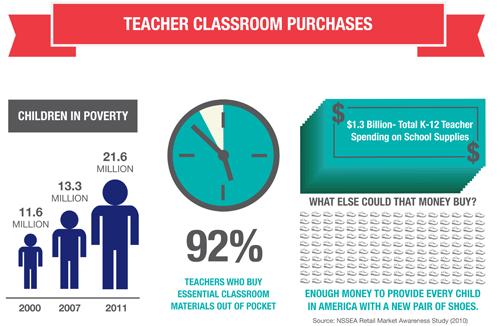Teachers are spending thousands of dollars of their own money to stock classrooms with basic supplies

School may be out for summer, but I guarantee you there’s one thing teachers are already worried about as they plan for the coming school year: how they’ll offset the inevitable out-of-pocket costs that come with running a classroom.
It’s not just a few books or art supplies we’re talking about here; the truth is much more discouraging. During my last year of teaching, I spent over $5,000 of my own money on my classroom during the year, and I know I wasn’t alone. On an annual salary of $42,000, that was hardly pocket change.
The Reason Teachers Have to Pay
In the United States, it has become increasingly clear, we just don’t value education.The average starting teaching salary in the US in 2012-2013 was $36,141, notably low considering that even intern teachers require a bachelor’s degree, plus credentialing for those who remain in the profession. In one of the country’s most expensive cities, San Francisco, a beginning teacher made just $47,902 during the 2014-2015 school year, far from enough to live on as a sole source of income when a1 bedroom apartment in SF averages $3,213/mo (that adds up $38,556 per year — more than 80% of the pre-tax income).
Every part of education in the United States has its own set of financial woes, but teachers bear the brunt of the burden. Many public schools, even districts located in wealthy areas, do not give their teachers any money for supplies; those that do may only provide $200 – $250 per classroom (and those funds are often distributed only to new teachers). In some areas, the PTA (parent-teacher association) steps in with a modest but helpful stipend to each teacher at the beginning of the school year. But even the more generous PTA grants of $500 or higher don’t provide for much past the initial setting up of a classroom. And relying on private donations only works in middle- and upper-class areas, thereby increasing disparity. I taught in a poor neighborhood in Oakland, and we never had a functioning PTA in the eight years I was employed there.
A Tour of Expenditures
I was shocked my first year of teaching, when I found myself spending several hundred dollars just to set up the classroom for the first day of school. The school provided desks, chairs, tables, textbooks, and not a lot beyond that. There were a few “free reading” books, but they looked like they were decades older than the children and hadn’t been treated well.
New and naïve, I asked the office where I’d get supplies. The office clerk let me into the supply room and counted out my supplies for the first part of the year: one box of crayons per child, two pencils per child, 10 rulers, lined paper, composition books, and some markers. She gave me some chalk and when I pointed out that I had whiteboards and needed dry erase markers, just shrugged and said, “Do you want the chalk or not?” I looked around and requested a stapler and staples, tape dispenser and tape, construction paper, and some more markers. That was all there was.
I asked where I got scissors, and the office clerk laughed and suggested I visit the nearest office supply store. Also not in the school supply room: permanent markers, paints in any color except shades of brown, paintbrushes, tissues, hand sanitizer, soap, glue, glue sticks, erasers, folders, pencil sharpeners, binders, or spiral notebooks.
Those were just the basics. A good teacher who wants to make her students feel welcome on the first day of school needs a lot more. Most of us buy welcome posters to hang on our door, writing our name and grade level, sometimes with all the Teachers are spending thousands of dollars of their own money to stock classrooms with basic supplies:
